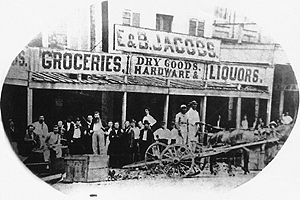Pushcarts and Plantations: Jewish Life in Louisiana facts for kids
Quick facts for kids Pushcarts and Plantations: Jewish Life in Louisiana |
|
|---|---|
 |
|
| Directed by | Brian Cohen |
| Release date(s) | 1998 |
| Running time | 54 min. |
| Country | United States |
| Language | English |
Pushcarts and Plantations is a 1998 documentary film. It tells the story of Jewish people in Louisiana, USA. The film was made by Brian Cohen, a director who has won awards for his work.
This documentary shares the 300-year history of Jewish communities. It includes interviews with historians and local people. You'll hear personal stories, fun facts, and learn about local heroes from North, South, and New Orleans.
Jewish History in Louisiana
The very first Jewish people to live in Louisiana were Sephardic traders. They came to the area a long time ago. Even though there were some unfair rules against Jewish people, their community grew strong.
More than a hundred years later, in the 1830s and 1840s, many Jewish families arrived. They came from a place in Europe called Alsace-Lorraine. These new settlers made their homes in northern Louisiana.
Blending Cultures
Over time, some Jewish people in Louisiana started to mix their Jewish traditions with Southern culture. The film shows two older women who wrote a special cookbook. It has Kosher-Creole recipes.
This cookbook teaches Jewish people how to make dishes like "Fake Frog's Legs." It also has "Oysters Mock-a-Feller," which is a kosher version of a famous New Orleans dish called oysters Rockefeller. Instead of oysters, they use gefilte fish.
Being Jewish in Louisiana
The documentary also looks at what it's like to be Jewish in a place where most people are Christian. One woman in the film explains, "Lafayette is not New York." She means that you are not surrounded by many other Jewish people there.
So, if you want to be Jewish in Louisiana, you have to be very active in your faith. One mother from Southern Louisiana shared her story. To have her children's bar and bat mitzvahs, she taught them Hebrew herself. Then, she had to drive them for hours to New Orleans for the ceremony.

